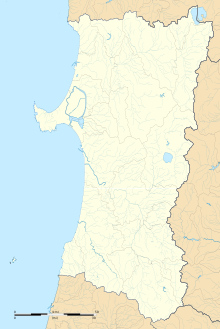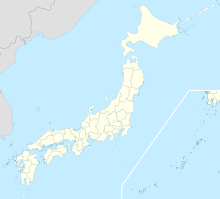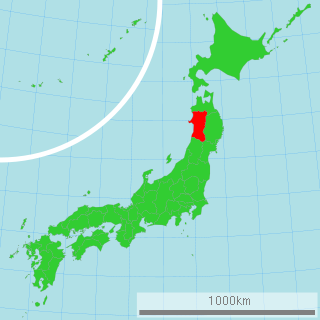
Akita Prefecture is a prefecture of Japan located in the Tōhoku region of Honshu. Its population is approximately 966,000 and its geographic area is 11,637 km2. Akita Prefecture borders Aomori Prefecture to the north, Iwate Prefecture to the east, Miyagi Prefecture to the southeast, and Yamagata Prefecture to the south.
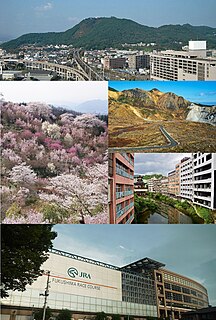
Fukushima is the capital city of Fukushima Prefecture, Japan. It is located in the northern part of the Nakadōri, central region of the prefecture. As of 1 May 2021, the city has an estimated population of 283,742 in 122,130 households and a population density of 370 inhabitants per square kilometre (960/sq mi). The total area of the city is 767.72 square kilometres (296.42 sq mi).
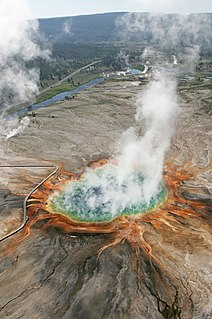
A hot spring, hydrothermal spring, or geothermal spring is a spring produced by the emergence of geothermally heated groundwater onto the surface of the Earth. The groundwater is heated either by shallow bodies of magma or by circulation through faults to hot rock deep in the Earth's crust. In either case, the ultimate source of the heat is radioactive decay of naturally occurring radioactive elements in the Earth's mantle, the layer beneath the crust.
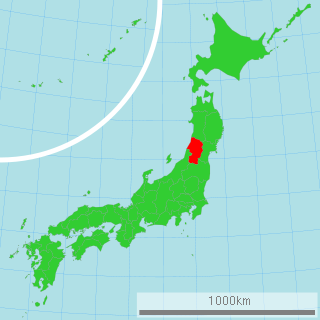
Yamagata Prefecture is a prefecture of Japan located in the Tōhoku region of Honshu. Yamagata Prefecture has a population of 1,079,950 and has a geographic area of 9,325 km². Yamagata Prefecture borders Akita Prefecture to the north, Miyagi Prefecture to the east, Fukushima Prefecture to the south, and Niigata Prefecture to the southwest.
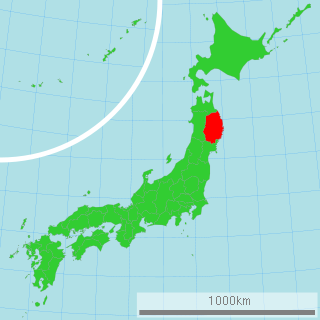
Iwate Prefecture is a prefecture of Japan located in the Tōhoku region of Honshu. It is the second-largest Japanese prefecture at 15,275 square kilometres (5,898 sq mi), with a population of 1,229,432. Iwate Prefecture borders Aomori Prefecture to the north, Akita Prefecture to the west, and Miyagi Prefecture to the south.
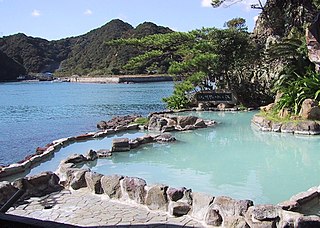
In Japan, onsen are the country's hot springs and the bathing facilities and traditional inns around them. As a volcanically active country, Japan has many onsens scattered throughout all of its major islands.

Hanamaki is a city in Iwate Prefecture, Japan. As of 31 March 2020, the city had an estimated population of 94,691, and a population density of 100 persons per km², in 37,773 households. The total area of the city is 908.39 square kilometres (350.73 sq mi). Hanamaki is famous as the birthplace of Kenji Miyazawa and for its hot spring resorts.

Yuzawa is a city located in Akita Prefecture, Japan. As of 31 December 2019, the city had an estimated population of 44,346 in 17,789 households, and a population density of 56 persons per km². The total area of the city is 790.91 km2 (305.37 sq mi). Yuzawa claims to be the birthplace of the famous Heian period poet Ono no Komachi.

Nozawaonsen is a village located in Nagano Prefecture, Japan. As of 1 April 2019, the village had an estimated population of 3,653 in 1395 households and a population density of 63 persons per km². The total area of the village is 57.96 square kilometres (22.38 sq mi).

Minakami is a town located in Gunma Prefecture, Japan. As of 31 October 2020, the town had an estimated population of 18,383 in 7938 households, and a population density of 24 persons per km². The total area of the town is 781.08 square kilometres (301.58 sq mi). Much of the town is within the borders of Jōshin'etsu-kōgen National Park.
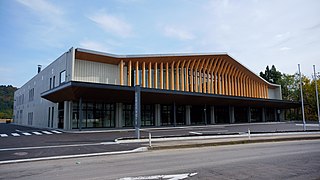
Semboku is a city located in Akita Prefecture, Japan. As of 31 December 2019, the city had an estimated population of 25,857 in 10,584 households, and a population density of 24 persons per km2. The total area of the city is 1,093.64 square kilometers (422 sq mi).
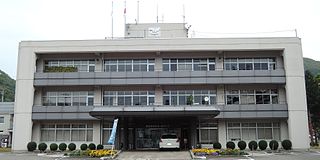
Nishiwaga is a town in Iwate Prefecture, Japan. As of 31 March 2020, the town had an estimated population of 5,468 in 2279 households, and a population density of 9 persons per km². The total area of the town is 590.74 square kilometres (228.09 sq mi). The total area was 825.97 square kilometres (318.91 sq mi).

Mount Hachimantai is the highest peak of a group of stratovolcanos distributed around the Hachimantai plateau in the Ōu Mountains in northern Honshū, Japan. This volcanic plateau is part of the Nasu Volcanic Zone and straddles the border between the Iwate Prefecture and Akita Prefecture. The volcano is listed as one of the 100 Famous Japanese Mountains, and forms part of the Towada-Hachimantai National Park.

Japan has favorable sites for geothermal power because of its proximity to the Izu–Bonin–Mariana Arc. In 2007, Japan had 535.2 MW of installed electric generating capacity, about 5% of the world total. Geothermal power plays a minor role in the energy sector in the country: in 2013 it supplied 2596 GWh of electricity, representing about 0.25% of the country's total electricity supply.

Takanoyu Onsen (鷹の湯温泉) is one of several hot springs in the Akinomiya Hot Springs area of the city of Yuzawa, in southern Akita Prefecture. The onsen is nestled in a small gorge along the banks of the Yakunai River. Because of its secluded location, it is referred to as a Hitou, or hidden hot spring.

Nyūtō Onsen is a rural hot spring resort in Towada-Hachimantai National Park, Semboku City, Akita Prefecture, Japan and consists of Japanese-style hot spring spas scattered around the base of Mount Nyūtō.
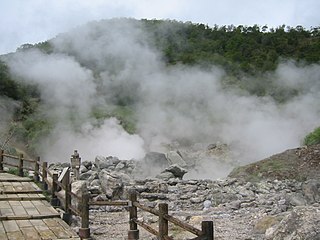
Unzen Onsen is a geothermally heated volcanic hot spring in the Unzen Mountains in Nagasaki prefecture in Japan. It was known of for many years, and in the 1910s was developed into a hot spring community because of its many springs. In 1934 the area was designated as the first national park in Japan.
Hakone Onsen, which is sometimes known as Hakone Hot Springs, is a general term for numerous thermal spas located in Hakone-machi, Ashigarashita-gun, Kanagawa Prefecture. Situated about 90 km southwest of Tokyo and 60 kilometers east-southeast of Mt. Fuji, it is one of the most popular hot spring resorts in central Japan. At least twenty hot spring spring resorts exist around Mt. Hakone, an area that is designated as part of the Fuji Hakone Izu National Park.

